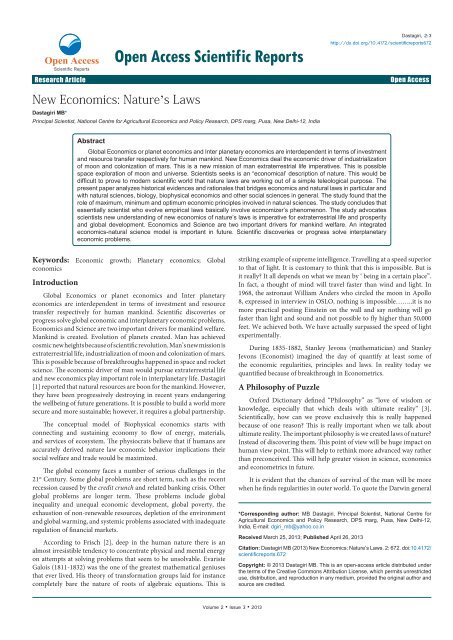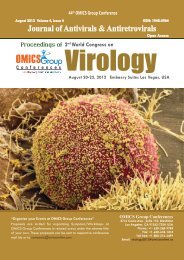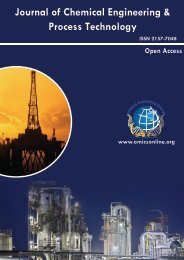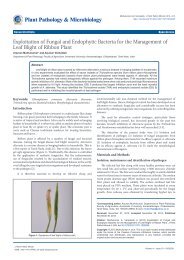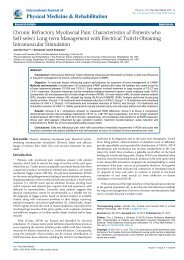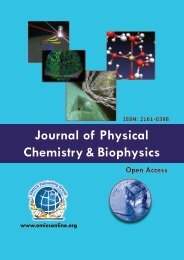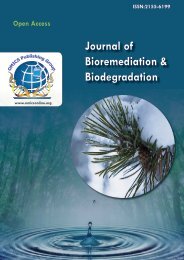New Economics: Nature's Laws - OMICS Group
New Economics: Nature's Laws - OMICS Group
New Economics: Nature's Laws - OMICS Group
Create successful ePaper yourself
Turn your PDF publications into a flip-book with our unique Google optimized e-Paper software.
Open Access<br />
Scientific Reports<br />
Research Article<br />
Open Access Scientific Reports<br />
Dastagiri, 2:3<br />
http://dx.doi.org/10.4172/scientificreports672<br />
Open Open Access<br />
<strong>New</strong> <strong>Economics</strong>: Nature’s <strong>Laws</strong><br />
Dastagiri MB*<br />
Principal Scientist, National Centre for Agricultural <strong>Economics</strong> and Policy Research, DPS marg, Pusa, <strong>New</strong> Delhi-12, India<br />
Abstract<br />
Global <strong>Economics</strong> or planet economics and Inter planetary economics are interdependent in terms of investment<br />
and resource transfer respectively for human mankind. <strong>New</strong> <strong>Economics</strong> deal the economic driver of industrialization<br />
of moon and colonization of mars. This is a new mission of man extraterrestrial life imperatives. This is possible<br />
space exploration of moon and universe. Scientists seeks is an “economical’ description of nature. This would be<br />
difficult to prove to modern scientific world that nature laws are working out of a simple teleological purpose. The<br />
present paper analyzes historical evidences and rationales that bridges economics and natural laws in particular and<br />
with natural sciences, biology, biophysical economics and other social sciences in general. The study found that the<br />
role of maximum, minimum and optimum economic principles involved in natural sciences. The study concludes that<br />
essentially scientist who evolve empirical laws basically involve economizer’s phenomenon. The study advocates<br />
scientists new understanding of new economics of nature’s laws is imperative for extraterrestrial life and prosperity<br />
and global development. <strong>Economics</strong> and Science are two important drivers for mankind welfare. An integrated<br />
economics-natural science model is important in future. Scientific discoveries or progress solve interplanetary<br />
economic problems.<br />
Keywords: Economic growth; Planetary economics; Global<br />
economics<br />
Introduction<br />
Global <strong>Economics</strong> or planet economics and Inter planetary<br />
economics are interdependent in terms of investment and resource<br />
transfer respectively for human mankind. Scientific discoveries or<br />
progress solve global economic and interplanetary economic problems.<br />
<strong>Economics</strong> and Science are two important drivers for mankind welfare.<br />
Mankind is created. Evolution of planets created. Man has achieved<br />
cosmic new heights because of scientific revolution. Man’s new mission is<br />
extraterrestrial life, industrialization of moon and colonization of mars.<br />
This is possible because of breakthroughs happened in space and rocket<br />
science. The economic driver of man would pursue extraterrestrial life<br />
and new economics play important role in interplanetary life. Dastagiri<br />
[1] reported that natural resources are boon for the mankind. However,<br />
they have been progressively destroying in recent years endangering<br />
the wellbeing of future generations. It is possible to build a world more<br />
secure and more sustainable; however, it requires a global partnership.<br />
The conceptual model of Biophysical economics starts with<br />
connecting and sustaining economy to flow of energy, materials,<br />
and services of ecosystem. The physiocrats believe that if humans are<br />
accurately derived nature law economic behavior implications their<br />
social welfare and trade would be maximized.<br />
The global economy faces a number of serious challenges in the<br />
21 st Century. Some global problems are short term, such as the recent<br />
recession caused by the credit crunch and related banking crisis. Other<br />
global problems are longer term. These problems include global<br />
inequality and unequal economic development, global poverty, the<br />
exhaustion of non-renewable resources, depletion of the environment<br />
and global warming, and systemic problems associated with inadequate<br />
regulation of financial markets.<br />
According to Frisch [2], deep in the human nature there is an<br />
almost irresistible tendency to concentrate physical and mental energy<br />
on attempts at solving problems that seem to be unsolvable. Evariste<br />
Galois (1811-1832) was the one of the greatest mathematical geniuses<br />
that ever lived. His theory of transformation groups laid for instance<br />
completely bare the nature of roots of algebraic equations. This is<br />
striking example of supreme intelligence. Travelling at a speed superior<br />
to that of light. It is customary to think that this is impossible. But is<br />
it really? It all depends on what we mean by ‘ being in a certain place”.<br />
In fact, a thought of mind will travel faster than wind and light. In<br />
1968, the astronaut William Anders who circled the moon in Apollo<br />
8, expressed in interview in OSLO, nothing is impossible……..it is no<br />
more practical posting Einstein on the wall and say nothing will go<br />
faster than light and sound and not possible to fly higher than 50,000<br />
feet. We achieved both. We have actually surpassed the speed of light<br />
experimentally.<br />
During 1835-1882, Stanley Jevons (mathematician) and Stanley<br />
Jevons (Economist) imagined the day of quantify at least some of<br />
the economic regularities, principles and laws. In reality today we<br />
quantified because of breakthrough in Econometrics.<br />
A Philosophy of Puzzle<br />
Oxford Dictionary defined “Philosophy” as “love of wisdom or<br />
knowledge, especially that which deals with ultimate reality” [3].<br />
Scientifically, how can we prove exclusively this is really happened<br />
because of one reason? This is really important when we talk about<br />
ultimate reality. The important philosophy is we created laws of nature?<br />
Instead of discovering them. This point of view will be huge impact on<br />
human view point. This will help to rethink more advanced way rather<br />
than preconceived. This will help greater vision in science, economics<br />
and econometrics in future.<br />
It is evident that the chances of survival of the man will be more<br />
when he finds regularities in outer world. To quote the Darwin general<br />
*Corresponding author: MB Dastagiri, Principal Scientist, National Centre for<br />
Agricultural <strong>Economics</strong> and Policy Research, DPS marg, Pusa, <strong>New</strong> Delhi-12,<br />
India, E-mail: dgiri_mb@yahoo.co.in<br />
Received March 25, 2013; Published April 26, 2013<br />
Citation: Dastagiri MB (2013) <strong>New</strong> <strong>Economics</strong>: Nature’s <strong>Laws</strong>. 2: 672. doi:10.4172/<br />
scientificreports.672<br />
Copyright: © 2013 Dastagiri MB. This is an open-access article distributed under<br />
the terms of the Creative Commons Attribution License, which permits unrestricted<br />
use, distribution, and reproduction in any medium, provided the original author and<br />
source are credited.<br />
Volume 2 • Issue 3 • 2013
Citation: Dastagiri MB (2013) <strong>New</strong> <strong>Economics</strong>: Nature’s <strong>Laws</strong>. 2: 672. doi:10.4172/scientificreports.672<br />
Page 2 of 5<br />
theory “Survival of the fittest”, which clearly says the man who is not<br />
fittest will be eliminated. And Lemark principle says that “use and disuse<br />
theory” are the best examples of survival of the man in regularities of<br />
outer world. This is what man is adopting since age old biologically and<br />
empirically [4].<br />
The present paper analyzes historical evidences and rationales that<br />
bridges economics and natural laws in particular and with natural<br />
sciences, biology, biophysical economics and other social sciences in<br />
general. The specific objectives of the paper are<br />
Objectives<br />
1. To analyze historical evidences and rationales that bridges<br />
economics and natural laws in particular and with natural<br />
sciences, biology, biophysical economics and other social<br />
sciences in general.<br />
2. To study the role of maximum, minimum and optimum<br />
economic principles involved in natural sciences. And to<br />
suggest strategies for new understanding of new economics of<br />
nature’s laws which is imperative for extraterrestrial life and<br />
prosperity.<br />
Data and Methodology<br />
The study is based on frame work of the history of intellectual<br />
thought that bridges economics and the social sciences on the one hand,<br />
with natural science and biology in particular on the other. The study<br />
analyzes historical evidences and rationales that bridges economics<br />
and natural laws in particular and with natural sciences, biology,<br />
biophysical economics and other social sciences in general. It also<br />
analyzes logically, mathematically and rationally the role of economic<br />
principles such as maximum, minimum and optimum principles<br />
involved in nature’s laws and finally the study suggest for scientists<br />
new understanding of new economics of nature’s laws is imperative for<br />
extraterrestrial life and prosperity. It is possible to build a globe more<br />
secure and more sustainable; however, it requires a global partnership.<br />
Results and Discussion<br />
<strong>Economics</strong> development in the last century<br />
In the past 19 th Century, John Stuart Mill (1806-1873) in his seminal<br />
work “Principles of <strong>Economics</strong>” quote that as of this time general<br />
principles concerned the theory of price and value fully explained and<br />
nothing to add by any author. At present as knowledge and science<br />
continuously progress it is difficult to understand such a stamen could<br />
be made. But Mills words seem to be close to the truth the generation<br />
of that time. Mills perceived in his “principles” the concepts of great<br />
economists Adam Smith (1723-1790), David Ricardo (1772-2823)<br />
and Thomas Robert Malthus (1766-1834) logical and complete. But<br />
classists and neo-classists not put efforts to verify theoretical results by<br />
statistical annotations [5].<br />
In the era of 20 th Century the philosophy changed. Due to criticism<br />
the theoreticians done systematic work and framed theory and linked<br />
to natural sciences. The theory derives its concepts from observation<br />
techniques. In 1968 Prof. Louis W. Alvarez [6], Physics Noble Laurites<br />
said: “Physics is the simplest of all the sciences… when we add small<br />
heat to the system the whole will be warmer and this is easy to predict<br />
but in infinitely complicated system such as the population of a<br />
developing country like India, no one can decide how best to change<br />
the existing conditions. This is problem of econometric planner and<br />
excuse not reached precision as well as physicists and hope we achieve<br />
in future.<br />
Principles of maximum, minimum and optimum in analytical<br />
economics and nature science<br />
Samuelson [5] described the economics maximization principle<br />
by mentioning its involvement in day to day life and quote maximum<br />
principle is inbuilt at the foundations of maximization subject. Joseph<br />
Schumpeter formulated famous claim that men operate struggle for<br />
survival is the Darwinian outcome. Just like thumb evolved to make<br />
living and brain evolved to meet economic problem. Konrad Lorenz<br />
and Nikolaas Tinbergen found similar findings in ethology [5].<br />
Schumpeter was articulated in launching of new econometrics<br />
subject. He claimed that physicist and natural scientists studied<br />
quantity later and sophisticated stage. The credit goes to the followers<br />
of Galileo and <strong>New</strong>ton for using mathematical approach. Schumpeter<br />
said in <strong>Economics</strong>, the subject matter itself in quantitative form, for e.g.<br />
Take away magnitude of price and barter exchange ratio then nothing<br />
is left.<br />
Maximum principle in natural sciences<br />
The falling of apple in vertical line and wondering of planet in<br />
elliptical orbit explained is based on principle of optimization rather<br />
fallacy of the freedom of apple and planet deliberately minimizing. It<br />
implies or nature takes the shortest course of action. Galileo’s ball rolls<br />
down the inclined plain are example of minimization of integral action<br />
or minimize Hamilton’s integral. This helped physicist to predict<br />
nature uniformities [6]. Scientists find Samuelson’s sophisticated<br />
methodology on “Revealed preference” provided a proof of human<br />
behavior studies to positively describe the maximizing problem.<br />
Mach reported that what scientists seek is ‘economical” description<br />
of nature [7]. It is difficult to prove this to modern scientific world<br />
that laws of nature are operating teleological purpose. Mach is not<br />
saying Mother Nature is an economist what he said that scientists who<br />
formulated empirical phenomena are inbuilt economizer. So physicists<br />
get better economical description of nature who formulates the laws of<br />
nature based on maximization principle. To illustrate this, <strong>New</strong>ton’s<br />
falling apple cane be written as; its acceleration toward the earth is a<br />
constant. Or its position as a function of time follows that arc which<br />
minimizes the integral.<br />
To illustrate the usefulness of minimum principle in physics: light<br />
travels between two points in the air before me along a straight line.<br />
Just like apple’s fall, the arc can be said the solution to minimization<br />
problem. But when light is reflected in mirror we may observe angle of<br />
reflection [5]. Observe big toe in the water, no longer it will be straight<br />
because of velocity of light differ in water and air travels or least time<br />
principle Fényes [8].<br />
Samuelson [5] explained the illustrative economics with an<br />
example of profit-maximizing firm that sells its output along a demand<br />
curve. He describes how the demand curve has tremendous economy<br />
description possible. He compared this economic principle with<br />
mathematics, thermodynamics and Hotelling integrality.<br />
The dynamics and maximizing<br />
Naturally there is a rich dynamics which can be related to<br />
maximizing. Thus consider the dynamic algorithm for finding the<br />
top of a mountain which consists of the ‘gradient method’ [7]. Frank<br />
Ramsey’s pioneering work (260 of more than forty years ago), they<br />
Volume 2 • Issue 3 • 2013
Citation: Dastagiri MB (2013) <strong>New</strong> <strong>Economics</strong>: Nature’s <strong>Laws</strong>. 2: 672. doi:10.4172/scientificreports.672<br />
Page 3 of 5<br />
provide a rich dynamics. Such a dynamics is quite different from that<br />
of say a positivistic accelerator- multiplier analysis.<br />
The concept of economics of the opportunity-costs frontier is<br />
not very different from the conventional mathematics of physics and<br />
maximization principles. It is clearly witnessed through one of the<br />
great lectures of Von Neuman around 1945 at Harvard on his way of<br />
describing the general equilibrium model.<br />
Empirical studies<br />
A study by Stokes [9] on ‘Man and the Biosphere to political<br />
economy’ reveals that the dialectical development of economic<br />
thought from the physiocrats through Marx to the present. It is a<br />
broad treatment of the history of intellectual thought that bridges<br />
economics and the social sciences on the one hand, with natural<br />
science and biology in particular on the other. The study is concerned<br />
with systems theory and treats the economy from the perspective of the<br />
biophysical thermodynamic dimensions of the economic process. The<br />
analysis is closed with a discussion of organizational theory that relates<br />
to the formation of institutions and the issue of freedom in a society<br />
dominated by technology. The study comes full circle in examining the<br />
moral and ethical concerns that first influenced the physiocrats and<br />
other founding fathers of economic science.<br />
Humanity and environment closely related and it requires rational<br />
choices. These were not made by design but it will be made by default.<br />
The economists view environment as composite asset which providing<br />
number of amenities. It depends on human actions and constrained by<br />
physical laws, such as the first and second laws of thermodynamics. The<br />
positive and normative economics help to use environment and natural<br />
resources efficiently. The positive economics deals actions of humans<br />
and impact on natural resources and normative economics guide<br />
on optimal services can be attained. Normative economics suggests<br />
two precise criteria for judging the optimal level and composition of<br />
services: efficiency and sustainability. The former suggests maximizing<br />
the present value of net benefits to society. When the use of natural<br />
resource in one period introduces scarcity or increases the degree of<br />
scarcity of that resource in subsequent periods, the efficient allocation<br />
must take the marginal user cost into account. Failure to do so would<br />
cause a smaller than efficient amount of the resource to be conserved<br />
Stadler [10].<br />
An integrated economics-natural science model (ECEMOD)<br />
used to describe non-point source pollution problem is presented.<br />
Results of analyses conducted over 20 years (for a sequence of climate)<br />
on small watersheds (silty, sandy and clayey soils) in Norway, were<br />
compared with a base scenario where no environmental regulations<br />
were introduced. Data including changes and variability in N leaching,<br />
and private and social costs are discussed. It is concluded that care is<br />
necessary when making policy recommendations based on ECEMOD<br />
simulations Romstad et al. [11].<br />
Focusing on agriculture, it is argued that part of the sustainability<br />
problems of farming, such as ground water pollution by nitrates, can be<br />
framed adequately in a natural science perspective. For sustainability<br />
problems related to nature conservation, a natural sciences perspective<br />
will not suffice. Three roles for the social sciences are distinguished<br />
with regard to sustainability agriculture: develop, support and evaluate<br />
policies that gear the practices of production and consumption to<br />
sustainability requirements; assess the moral and aesthetic values<br />
underlying nature conservation, in order to underpin cultural<br />
sustainability requirements; and develop and test future-oriented<br />
models that meet the claims to agriculture in an integrated way Koppen<br />
[12].<br />
An overview is presented of ecological economics, a discipline<br />
lying at the interface of economics, natural science, and philosophy,<br />
focusing on the concepts and methods required integrating sciences<br />
and humanities in order to build ecological economics. The<br />
central dilemma of control over nature by humans ignorant of the<br />
environmental impacts of their actions is addressed. An argument is<br />
put for an evolutionary approach to human - nature interactions and<br />
for the use of natural science concepts, such as entropy Faber et al. [13].<br />
In studies in Michigan, the sphecidpassaloecuscuspidatus was<br />
observed gathering fresh pine resin (pinusstrobus) which they<br />
used for creating partitions and closures in their nests. Based upon<br />
measurements taken of the cells, and an estimate of the load carried<br />
by the wasps, the number of collecting trips made by the wasps<br />
was correlated with the quantity of resin contained within the nest<br />
partitions and closures Fricke [14].<br />
The constraints and opportunities to understanding the complex<br />
relationships between environment and society are highlighted. The<br />
political and social aspects of constructing a natural science view of the<br />
environment-society relationships are then presented called ‘ political<br />
ecology’. Having established a methodology that links different levels<br />
and scales, this is illustrated by taking the case of land degradation.<br />
Examples are drawn globally, but mostly from African countries Blaike<br />
and Morse [15].<br />
According to Milton, anthropology has a distinctive contribution<br />
to make to current debates on ‘green’ issues. Drawing on studies in<br />
sociology and law, as well as anthropology, the contributors challenge<br />
the view that environmental issues are the province of natural science<br />
alone and explore the interdisciplinary nature of the environmental<br />
ideology and imagery, and environmental law and policy, through<br />
local environmental activism, to ethnographic analyses of human/<br />
environment relations in indigenous societies. Milton [16].<br />
Tietenberg [17] study reviews current economic research on<br />
climate change, including challenges in performing assessments on<br />
a problem of this inters temporal complexity. Initial studies indicate<br />
both gainers and losers from climate change and significant costs<br />
for some abatement strategies. Research problems are also noted,<br />
including a lack of usable natural science information for some<br />
important long-term consequences. In general Environmental and<br />
natural resource economics focus on economic development within<br />
limited environmental and natural resources Tietenberg [17].<br />
Ekveland [18] reported the history of biophysical process from<br />
18 th Century physiocrats to recent empirical studies. He said that<br />
Biophysical economics includes various analysts from different<br />
specializations who apply ecological and thermodynamic principles to<br />
study the economic phenomenon.<br />
Christensen [19] recognized the interdependence of economic<br />
activities of living bodies’ physiological analogy to nascent materials<br />
production. He reported that the progress of ecological economics<br />
demands a radical rethinking of economic theory. The study suggests<br />
that synthesis of classical production model with insights of ecological<br />
and system approach is vital for future direction of integration of<br />
physical, information and organizations approach to economic activity<br />
[19].<br />
Kaufmann [20] analyzed the areas in which Marxist economists and<br />
biophysical economists benefit each other analysis. Marxists economist<br />
Volume 2 • Issue 3 • 2013
Citation: Dastagiri MB (2013) <strong>New</strong> <strong>Economics</strong>: Nature’s <strong>Laws</strong>. 2: 672. doi:10.4172/scientificreports.672<br />
Page 4 of 5<br />
benefits in production and biophysical economists benefit valuation and<br />
distribution. For Marxists can understand how biophysical economists<br />
classify production and for biophysical economists understand social<br />
forces effects physical production.<br />
Dastagiri [21] suggested strategies for food for planet is that<br />
research into sustainable farming systems, essential for the preservation<br />
and enhancement of the earth’s life support system, which is a primary<br />
conservation goal. Future policies demand that any ‘green revolution’<br />
increase production in many folds in an economically profitable,<br />
socially equitable and environmentally friendly.<br />
Tobisson and Rudqvist [22] reported that the existence of natural<br />
science and economic bias confuses the relationships between local<br />
social group and natural resources utilized and managed. This bias<br />
constitutes an “environmental Experts”.<br />
Goswami [23] reported that the physical universe of matter<br />
exhibits evolution. The galaxies segmented as the universe expands.<br />
The galaxies themselves evolve. Stars evolve too and at old stage, stars<br />
end up as white wares or neutron stars or block holes.<br />
Daily and Ellison [24] reported that historically, the service<br />
of nature has been thought mostly free. We have not taken even<br />
ecosystem capital stocks. We do not have formal system of appraising<br />
and monitoring the value of nature’s assets and means of insuring them<br />
against their damage.<br />
Barker [25] described that <strong>New</strong> Economic thinking is an<br />
interdisciplinary strategy or methodology to economic problems that<br />
very well take insights and analysis from other disciplines, particularly<br />
from natural scientists, ethics, history, engineering and evolutionary<br />
theory and complexity.<br />
Callaway [26] make use of population-genetic data to predict<br />
economic success. <strong>Economics</strong> researchers who claim that a country’s<br />
genetic diversity can predict the poverty and success of its economy.<br />
Foundation Earth [27] reported on “the big rethink to a better<br />
world” that if every country adopts changes as suggested we and planet<br />
would be well the way to socially and ecologically sensible way of living.<br />
This is a meaningful shift to a better world.<br />
Esteban [28] reported that nature supports our social and economic<br />
systems. It allows life on Earth possible and worth living. It plays vital<br />
role in economic and environmental development. In spite of that we<br />
fail to realize its potential.<br />
Conclusions<br />
Planet economics and Inter planetary economics are interdependent<br />
in terms of investment and resource transfer respectively. <strong>New</strong><br />
<strong>Economics</strong> deal the economic driver of industrialization of moon and<br />
colonization of mars. This is a new mission of man extra-terrestrial<br />
life imperatives. The study found that essentially scientist who evolve<br />
empirical laws basically involve economizer’s phenomenon. If man<br />
finds regularities in outer world his survival will be very high. Physicist<br />
and other natural scientists studied quantity at a very late whereas in<br />
<strong>Economics</strong>, the subject matter is designed in quantitative form. The role<br />
of maximum, minimum and optimum economic principles involved<br />
in natural sciences. The physicists should frame the observed laws by<br />
a maximum principle in order to get more economical description of<br />
nature.<br />
To understand intricacies between humanity and environment,<br />
ecology requires rational choices necessary if not made by design.<br />
Biophysical economics includes wide range of researchers who<br />
apply ecological and thermodynamics laws to the economic process.<br />
<strong>Economics</strong>-natural science model is important to study human-nature<br />
science in future.<br />
The study found that the role of maximum, minimum and<br />
optimum economic principles involved in natural sciences, physics<br />
and human behavior. The study concludes that essentially scientist<br />
who frame empirical laws basically involve economizer’s. The study<br />
advocates scientists to understand new economics of nature’s laws for<br />
extra-terrestrial life and prosperity. Scientific discoveries or progress<br />
solve interplanetary economic problems.<br />
References<br />
1. Dastagiri MB, Kantharaju ML, Nadagoud VB (1997) G-7 Countries Natural<br />
Resources Utilization in the Global Scenario: Policies and Prospects. Indian<br />
Journal of <strong>Economics</strong> 3: 199-214.<br />
2. http://nobelprize.virtual.museum/nobel_prizes/economics/laureates/1969/<br />
frisch-lecture.pdf.<br />
3. www.math.lsa.umich.edu/news/CID_math_Bass.pdf.<br />
4. Rugina AN (2003) 3. Nobel Laureate: Paul A. Samuelson (1915- ). International<br />
Journal of Social <strong>Economics</strong> 30: 424 – 452.<br />
5. Samuelson PA (1970) For the Scientific work through which he has developed<br />
Static and Dynamic Economic theory and actively contributed to raising the<br />
level of analysis in Economic Science, Noble Lectures, Economic Sciences,<br />
World Scientific, Singapore, <strong>New</strong> Jersey, London, Hong Kong 53-62.<br />
6. http://www.lbl.gov/LBL-PID/Nobelists/Libl Alvarez.html.<br />
7. Assar Lindbeck, Economic Sciences (2013) The SverigesRiksbank (Bank of<br />
Sweden) prize in economic sciences in memory of Alfred Nobel 1969-2007.<br />
World scientific publishing co.<br />
8. Fényes TI (1992) Sustainable agricultural development: The role of international<br />
cooperation, XXI International Conference of Agricultural Economists, 22-29<br />
August 1991, Tokyo, Japan. Development Southern Africa 9: 105-115.<br />
9. Stokes KM (1992) Man and the Biosphere: Toward a Coevolutionary Political<br />
Economy, Graduate School of International Relations, International University<br />
of Japan, Tokyo, Japan. 12: 323.<br />
10. Stadler P (1990) Ultrasonography of the equine thorax, pferdeheilkunde 6: 213-<br />
228.<br />
11. Romstad E, Vatn A, Bakken LR, Botterweg P, Romstad E, et al. (1997)<br />
<strong>Economics</strong> Ecology Modeling - the case of Nitrogen, Controlling mineral<br />
emissions in European agriculture. <strong>Economics</strong>, Policies and the Environment<br />
23: 225-248.<br />
12. Koppen Van CSA (1997) Social Dimensions of Sustainable land use. Tijdschrift<br />
voor Sociaalwetenschappelijk Onderzoek van de Landbouw 12: 122-136.<br />
13. Faber M, Manstetten R, Proops J (1996) Ecological <strong>Economics</strong>: Concepts and<br />
Methods. Ecological economics: concepts and methods xiv: 342.<br />
14. Fricke JM (1995) <strong>Economics</strong> of Cell Partitions and Closures Produced by<br />
Passaloecus cuspidatus (Hymenoptera: Sphecidae). Great Lakes Entomologist<br />
28: 221-223.<br />
15. Blaikie P, Morse S (1995) Records Understanding environmental issues.<br />
People and environment 1995: 1-30.<br />
16. Milton K (1993) Environmentalism: The view from Anthropology. ASA<br />
Monographs X: 240.<br />
17. Tietenberg T (1992) <strong>Economics</strong> of the Environment: An Overview.<br />
Environmental and Natural Resource <strong>Economics</strong> 18-43.<br />
18. Ekveland CJ (1987) Biophysical <strong>Economics</strong>: Historical Perspective and Current<br />
Research Trends. Ecological Modeling 38: 47-73.<br />
19. Christensen PP (1987) Classical roots for A Modern Materials: Energy analysis.<br />
Ecological modeling 38: 75-89.<br />
20. Kaufmann RT (1987) Biophysical and Marxist <strong>Economics</strong>: Learning from each<br />
other. Ecological Modeling 38: 91-105.<br />
Volume 2 • Issue 3 • 2013
Citation: Dastagiri MB (2013) <strong>New</strong> <strong>Economics</strong>: Nature’s <strong>Laws</strong>. 2: 672. doi:10.4172/scientificreports.672<br />
Page 5 of 5<br />
21. Dastagiri MB (1998) World Food Production Research. Out Look on Agriculture<br />
77-80.<br />
22. Tobisson E, Rudqvist A (1992) Popular Participation in Natural Resource<br />
Management. Stockholm: Development Studies Unit, Department of Social<br />
Anthropology, Stockholm University. 11: 41- 45.<br />
23. Goswami A (2000) The Physicists View of Nature- from <strong>New</strong>ton to Einstein<br />
(Part1). Kluwer Academic, <strong>New</strong> York.<br />
24. Daily GC, Ellison K (2002) The new economy of nature. Orion magazine.<br />
25. Barker T (2005) Towards new thinking in <strong>Economics</strong>. The Cambridge Trust for<br />
<strong>New</strong> Thinking in <strong>Economics</strong>.<br />
26. Callaway E (2012) <strong>Economics</strong> and genetics meet in uneasy union. Nature 490:<br />
154–155.<br />
27. Foundation Earth (2012) The economic rethink who does it well.<br />
28. Esteban A (2012) Nature’s role in delivering well-being and key policy goals –<br />
opportunities for the third sector. Natural solutions.<br />
Volume 2 • Issue 3 • 2013


